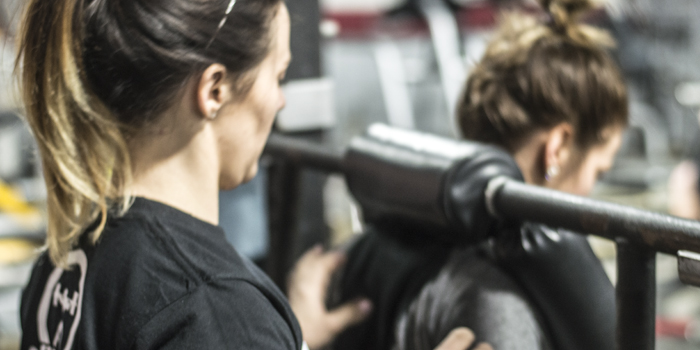
In the modern world of coaching where information is at our fingertips, it is no wonder some of us try to do too much by losing other ideas in the translation. Experience gives coaches a filter to utilize information that applies to our situations. Some of this can be misdirected due to the inability to combine prior knowledge with intuition.
Coaching cues have been on the forefront of communication strategies for coaches. The ability to say more with fewer words is an imperative skill needed in the ADHD generation of athletes. Coaches like Nick Winkleman and my friend Brett Bartholomew have transformed this process into a coaching pedagogy of sorts. Without a doubt, coaching cues are a core concept and have several different categories.
Verbal Cues — Internal (example: knees out) and External (example: push your feet through the floor)
Visual Cues — Demonstration and Feedback
Tactile Cues — Hands-On, Accommodating Resistance, Varied Surfaces
The most important point is that most coaches use verbal internal cues, which may be the least effective. What compounds this thought process is those cues may do more harm than good if chosen poorly. Here are three that I feel fit that category.
1. High Knees
High knee drills are often commonplace in a variety of settings. They are often utilized in pre-practice or pre-speed training sessions. One thing to understand is that high-knee drills and cueing high-knees are not the same. The intention of any drill where the mechanics of sprinting are simulated or progressed to is absolutely welcome. Where the problem lies is how the athletes are being told to "bring their knees up high."
Gone are the days where you would have any athlete bring their knees up to their chest as high as possible. Dynamic warm-up or not, this drill is as far from biomechanically sound to prepare an athlete for sprinting as there can be. I am in no way an expert on speed, and I will be the first to admit that training elite track athletes is vastly different from training field or court, team sports as I've written about extensively here. Almost all linear speed enhancement with athletes in a team setting will deal with the acceleration phase of the sprint. Our basic progression was probably over-simplified (below), but simply put, the foot of the front side leg will rarely rise above opposite knee level.
By instructing an athlete to pump his or her knees any higher, several technique discrepancies can happen:
- The athlete will lose proper posture and appropriate forward lean.
- The athlete will create a more vertical shin angle which will alter ground contact forces.
- The timing of the frontside/ backside mechanics cycle will be inhibited.
The emphasis for the acceleration phase through the top-end phase will differ, but none will benefit from the athlete bringing their knees to their chest. I also talk about some other ways I made my athletes slower in this article.
Better cues to use: focus on arm swing, driving the knee forward, and producing force against the ground.
2. Land Soft
My first ten years of coaching were filled with mistakes. Using cues like "landing soft" was a big one. Instructing athletes to land in a controlled position and absorbing the force of landing seems like a natural progression. It is almost counter-intuitive for some coaches to do otherwise as the tendency to protect the athlete supersedes all other aspects of landing. We as coaches tend to lean toward safety over performance when it comes to any eccentric contraction or deceleration phase of movement. This is with good reason, as almost all lower-extremity, non-contact injuries happen during landing, cutting, or braking on the field or court.
Focusing on altitude landings, deceleration technique, and change of direction mechanics are all solid investments in an athlete's health and performance. Landing is a skill improved by neurological efficiency (unconscious competence) and correcting muscular imbalances (posterior chain). But with all the emphasis on improving landing mechanics, are we sabotaging it with our own cues?
Nowadays, everyone is an Olympic lifting expert and coaches aren't afraid to display their intellectual prowess via social media. I am far from an expert and my experience is with large groups with minimal time. I wrote about training the Olympic lifts in a team setting here. That being said, when looking at an athlete catch a snatch or clean, it takes me about three seconds to know if they are strong enough to progress past their technique flaws. The question is always, "how strong do you have to be in other lifts (squats, pulls) to lift x amount of weight on the platform?"
Watching an athlete catch a clean in the power position and then have that weight force them down to a front squat, then the athlete is weak. If the weight hits your rack position and you descend afterward, you aren't strong enough. It doesn't take much video to figure that out. That leads to my biggest issue with teaching a soft landing. It is almost as bad as teaching a soft catch position.
An even bigger issue when an athlete lands softly on top of a box or on the ground is simply this: They will never land that way on the field or court. The whole purpose of landing or decelerating is to do it as quickly as possible in order to produce force in a different or opposite direction. Landing slowly and softly disables that process. Athletes need to land in a great athletic position (which should resemble or even replicate the power position) with proper joint angles and no additional and unnecessary movement or alteration in posture.
Better cue to use: land strong,
3. Pinch Your Shoulder Blades Together
This is a cue that coaches use continuously, as the need for athletes to maintain scapular retraction throughout the duration of almost all weight room movement warrant a great deal of emphasis. In fact, there are companies who have made an exorbitant amount of money inventing already-invented equipment to perform already-invented variations of scapular retraction. You can use elitefts bands for a fraction of the cost, but that's none of my business. Here's an example of some of these movements from a low position and high position.
The key with maintaining a proper shoulder position (specifically with the scapula) are to have the athlete retract AND depress the scapula. What often happens when the athlete attempts to simply "pinch their shoulder blades" is their shoulder girdle elevates like a shrug. With the shoulders elevated, pressing and pulling movements can lose efficiency of movement and jeopardize shoulder health. The cue itself is not the issue as long as the desired shoulder position is achieved. Below is a video Nick Showman and I did on achieving the athletic "power" position which includes proper position in the thoracic spine.
Better cues to use: "Shoulder blades in your back pockets" or even "chest up."
The one aspect of this list that is 100% true is that it's not complete. There are undoubtedly many other cues that coaches use that could be replaced for the betterment of those athletes. There is never right or wrong in these cases, just coaches finding better ways to help their athletes achieve more.











I am also a victim of #2, for that exact reason, I don't want my athletes getting unnecessary injuries from plyos in training. Some people land so forcefully and loud that it makes me cringe. But it is true, even in my case training military members to jump out of trucks, there isn't much room for a graceful landing, much better value in teaching them to forcefully land in control.